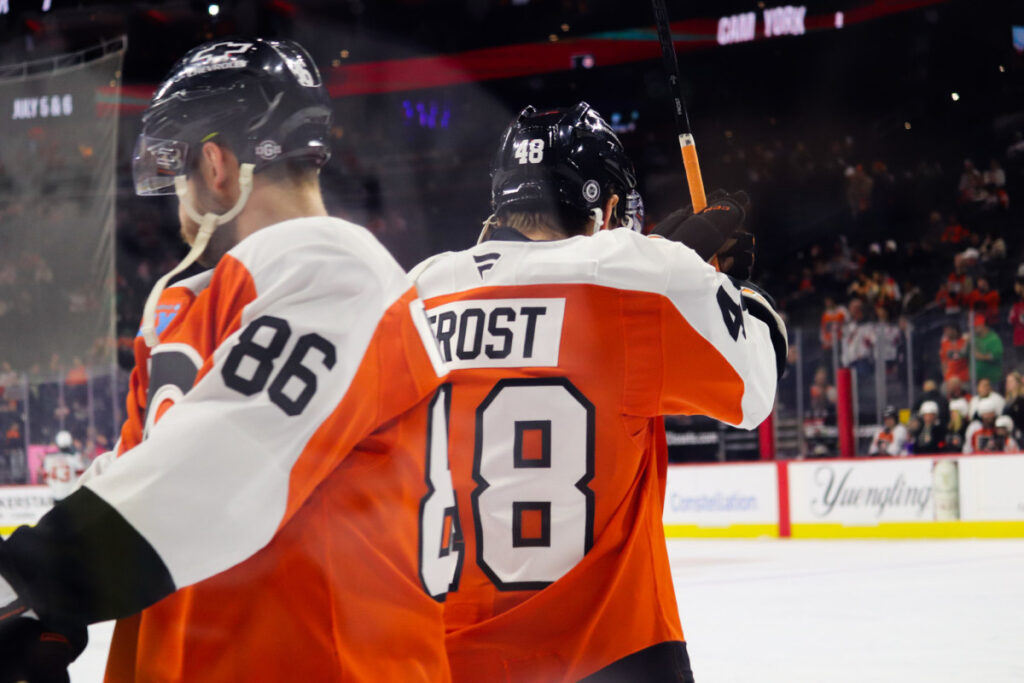The Philadelphia Flyers sent shockwaves through the hockey world with their recent trade of forwards Joel Farabee and Morgan Frost to the Calgary Flames in exchange for Andrei Kuzmenko, Jakob Pelletier, a 2025 second-round pick, and a 2028 seventh-round pick.
Flyers General Manager Danny Briere held a press conference on Saturday to provide more insight into the rationale behind the trade, shedding light on the complexities of modern roster building and the difficult decisions required to steer the franchise forward.
While fans may be grappling with the departure of two homegrown players, Briere’s comments paint a picture of a front office navigating a delicate balancing act between player development, salary cap management, and the pursuit of long-term competitiveness.
View the original article to see embedded media.
Cap Flexibility: A Necessary Factor
One of the most immediate and significant takeaways from Briere’s remarks was the emphasis on financial flexibility. The NHL’s flat salary cap has created challenges for many teams, and the Flyers are no exception.
With Farabee carrying a long-term contract and Frost approaching a payday, the financial considerations played a pivotal role in the trade.
“The biggest thing in all of this is the cap flexibility that it gives us moving forward. Maybe not this year per se but moving forward,” Briere explained. “It’s no secret that, especially in Joel’s case, the cap hit moving forward was tough. Most of the discussions we had, teams were not willing to take on his full salary, especially with the term left on it.”
Farabee’s six-year, $30 million contract, which carries a $5 million annual cap hit through 2028, was a significant burden for a rebuilding team looking to maintain financial agility. Although Farabee had showcased plenty of promise, he also struggled with some inconsistent production, which made it difficult for teams to see him as a clear-cut solution to their top-six needs.

Megan DeRuchie-The Hockey News
“Morgan was also getting closer to getting paid a lot more money,” Briere added. “Again, it goes back to the players and the development of the players around them. We are a little different than we’ve ever been, I think, within the Flyers organization where there are a lot more prospects coming in.”
These comments suggesr that while Farabee and Frost had been central to the Flyers’ plans just a few years ago, the organization’s shifting dynamics and influx of promising prospects created a situation where both players weren’t as good of a fit for the future as initially thought.
Player Development and Evolving Expectations
Briere spoke candidly about how the emergence of other young talent influenced the decision to part ways with Farabee and Frost. The Flyers have seen growth from other players in the young core, and it became increasingly clear that the team needed to make room for this new wave of talent.
“We felt that around them, guys were going by them,” Briere admitted. “We had higher hopes, I would say, for Morgan and Joel just maybe two years ago. Some guys were starting to go by them.”
The Flyers’ front office had to make a difficult assessment: Could Farabee and Frost elevate their games to keep pace with the organization’s rising stars, or had their development with the Flyers plateaued? Ultimately, it sounds like the team believed the latter was true.
The Emotional Toll
While the trade was rooted in logical considerations, Briere did not shy away from acknowledging the personal difficulty of the decision. Both Farabee and Frost had been integral parts of the Flyers’ locker room, and Briere had a particularly close relationship with Frost.
“It’s not an easy trade, believe me. It’s a really tough one. You’re shipping out two really quality people in Joel and Morgan,” he said. “Especially for myself, it’s a tough one. When I came into the organization about five or six years ago, one of my first tasks was really to work with Morgan.
“My relationship with him was pretty special. We spent a lot of time together early on, but that’s the job that I have [as general manager]. I’m here to make the tough decisions, and that’s certainly one of them for me, on a personal level.”
While many commentaries on this trade have lacked nuance and empathy for how the loss of Frost and Farabee impacts the Flyers, Briere’s remarks underscore the human side of hockey operations. The reality is that decisions are not made in a vacuum but with an acute awareness of the persona bonds formed between players, coaches, and management.
“Those two guys were great around the room, and there certainly weren’t any problems in the locker room with them,” Briere clarified. “We thank them for what they did for us. They were great teammates.”
The Trade Market and Calgary’s Role
The path to finalizing the trade was not straightforward, as Briere detailed the challenges of finding teams willing to take on Farabee’s full salary and navigating concerns about Frost’s value.
“I’ve had many discussions [with teams]. We are always checking in with different teams on a daily basis,” he explained. “There were no teams really that showed any interest in taking on the full salary for Joel until Thursday during the day when the talks escalated with Calgary.”
The Flames’ willingness to absorb Farabee’s contract was a turning point in negotiations, and their interest in Frost provided a rare opportunity for Briere to make a deal that aligned with the Flyers’ long-term goals.
“As far as Morgan, yeah, there were a few teams, but the way this season had been going, the ups and downs, a lot of teams were really worried, and the value just wasn’t there until we had the talks with Calgary,” he noted.

Megan DeRuchie-The Hockey News
The Flyers’ ability to secure Kuzmenko, Pelletier, and some draft capital speaks to the front office’s strategic approach. Kuzmenko brings immediate offensive upside, while Pelletier, at 23, fits neatly into the team’s youthful core.
A Forward-Thinking Move
Briere’s transparency about the motivations behind the trade offers fans valuable insight into the complexities of managing an NHL roster and how, in a rebuild, necessary decisions are very rarely the easy ones to make. The depature of Farabee and Frost marks the end of an era for two players who once symbolized the Flyers’ future but ultimately were in need of a new beginning.
“For Frosty and I, it’s a little fresh start … these guys are playing really well right now and in a great spot, hopefully we can just add to that.”
Joel Farabee checks in after his first skate with the #Flames! pic.twitter.com/GqzBreOiP7
— Calgary Flames (@NHLFlames) February 1, 2025
However, the addition of Kuzmenko and Pelletier, coupled with the financial flexbility gained from the trade, positions the Flyers to continue their rebuild with a clearer path forward.
As fans adjust to the loss of two familiar and beloved faces, they can take solace in the fact that the Flyers are committed to creating a sustainable and successful future. Not to mention that both Frost and Farabee have been given a chance to start over and unlock their full potential—even if it means East Coast fans will have to stay up for 10:00 PM puck drops.
Related: Get To Know New Flyers Players Andrei Kuzmenko And Jakob Pelletier
Related: Danny Briere Emphasizes That Flyers Are Still Rebuilding, Will Be ‘Open For Business’ On Trades
Related: Joel Farabee Highlights Impact Of Healthy Offseason, Praises Flyers Young Core
#Flyers #Details #Joel #Farabee #Morgan #Frost #Trade

